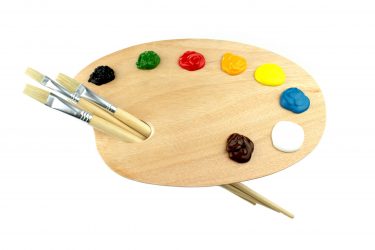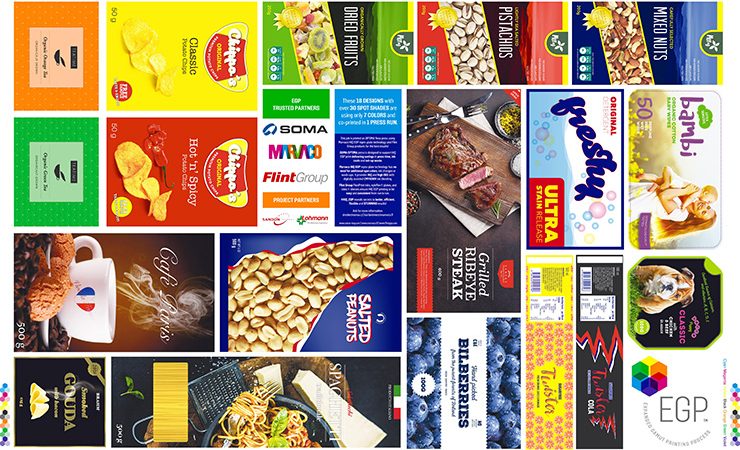Streamlining the printing process is essential today as many flexo print providers struggle with the market for shorter runs and faster delivery times, increasing the production pressure on converters. Sean Smyth looks at how using a fixed colour palette could help.
Press time is always lost at changeover and make-ready, as plates are mounted and spot colour inks are mixed and loaded onto the press. By using quick changeover methods with closed ink chambers wash-up can be carried out off-line, limiting downtime. However, this still needs labour to carry out the washing, and to mix the ink. Makeready time and waste can be extended to get the spot colours correct, meaning that as the number of make-readies increases there is less production time available. Methods of boosting productivity are being widely adopted, with lean manufacturing and applying advanced automation. Another method involves re-engineering the pre-press operation, using a range of standard process colours that can be used on all jobs.
Fixing the palette
The principal is fairly straightforward. Instead of using pre-mixed inks to reproduce special colours, users employ a six- or seven-colour process set and match spot colours from these inks. The colours that can be reproduced depend on the combination of inks used, usually cyan, magenta, yellow and black; with orange, violet and/or green. Using more inks than in standard four-colour printing means more colours can be achieved, extending the potential colour gamut hence one of the names, Extended Colour Gamut (ECG) printing. Suppliers claim that 85% or 90% of the Pantone range can be matched, many companies offer swatch books showing the colours with the necessary mixes to customers and designers to ensure that the optimal mix is specified. The pre-press separations involve specialist software that determines the accuracy of colour matching, and some systems allow
out-of-gamut warning for any colours that cannot be matched precisely from the combination of inks being used. In this case converters can pre-empt problems by talking with brands and showing them how the closest match will appear.
Provided that the colour can be matched – and there are always some specials that cannot – there are several benefits for flexo printers using the technology:
- Easier design and repro with a standardised colour set
- Lower costs through shorter make-readies and fewer plates
- Savings on special ink matching and waste, with no stocks
- Faster press make-ready and fewer wash-ups, increasing output capacity and press efficiency
- Several designs can be ganged together if the formats and substrates allow, reducing the requirement for plates and set-ups
- It can reduce the time to market for designs, helping speeds up turnaround
Dan Pulling is senior application specialist at Esko and he has considerable experience in helping flexo printers adopt fixed palette printing. ‘It represents about 5% of European wide web flexo production today, and this will grow to 20% in the next five years as more brands and converters understand what it has to offer. The fact that many of the leading press manufacturers are now showcasing FCP methods in their demonstrations as a tool to boost productivity on new highly automated presses is helping boost the market. Saving a few minutes in a quick changeover is wasted when you have to set the spot colour levels in a long make-ready.’ He explained that the average run length for a wide web flexo press has fallen, from some 30,000 down to 15,000 in 2018. This means that there are many more make-readies, so any savings in time and waste become increasingly important. Esko has a range of tools in its armoury to help printers implement fixed colour palette printing.

On the press
One of the press suppliers pushing the technology is Czech press manufacturer Soma. The company highlighted the method at its annual Flexo Challenge Conference 2018, held in the Czech Republic in May, together with pre-press company Marvaco (the biggest flexo plate producer in the Nordic countries) and Flint Group, where various designs were printed live for the audience.
Soma stresses the importance of press consistency and control, delivering a consistent stable dot through the mechanical press properties. Soma’s advanced bounce control system eliminates bounces at full press speed while maintaining register and consistent ink transfer. The demonstration combined 18 designs into a single forme featuring more than 30 colours, printed with only 7+1 colours – in one pass onto BOPP. The company is also pushing flexo as an alternative for gravure printers looking to reduce cost, the demo showcasing designs which would have previously been printed with gravure using a line screen of 178 lpi (70 lpcm). The result was smooth solids, fine text, with high details and elements with tight tolerances were all brought together in a single design.
Fixed palette printing makes flexo a more competitive printing technology compared to traditional gravure as well as digital by increased quality and productivity.
Bobst has been an initiator of fixed colour palette printing in packaging. In 2013, it launched the Revo Digital Flexo project, successfully making a turnkey seven-colour Extended Colour Gamut (ECG) process and digitised workflow for labels, flexible packaging and carton production. Revo is a closed loop solution with fixed partners for consumables, hardware and software equipment and devices. The ECG system was introduced in 2018 for the wide-web 20SEVEN CI flexo printing presses in an open system, with solvent or waterbased inks and with different pre-press suppliers. Bobst has introduced a test certification system to ensure the results.
In 2017 Bobst introduced a fixed colour palette for corrugated board post-print, called THQ (Très Haute Qualité = very high quality) FlexoCloud technology. This creates spot colours from the process colours and there is an integrated process with printing plates and inks from exclusive suppliers and a cloud application for coordinating production. ‘Bobst was an initiator of the industry move towards the fixed colour palette printing, which is a strategy we are committed to, at Group level,’ explained Federico D’Annunzio, strategic products marketing director, Bobst business unit web-fed. ‘We continue to progress by delivering solutions that deliver the best overall results for converters which might not yet be suitable for a standardisation of the whole process.’
Down to the dots
There are potential problems, however. Producing spot colours from overlapping dots of process inks may lead to visible artefacts or grain, in the worst case moiré and angle clashing. So while the colour measurement may be accurate, the appearance of a flat tint may not be as smooth as a spot colour (and flexo printers know the tricks of adding white and pushing the ink setting up to get a very smooth result). Platemakers may use different screening techniques to minimise these impacts, software house Hamillroad Software is reporting success with its Bellissima DMS (Digitally Modulated Screening), a specialist form of FM screening, to eliminate screen angle
clashes and rosettes, using uniform dot sizes through the tone scale. DMS is matched to the platemaking and press conditions, precisely controlling the dots in each colour and between the colours.
The company claims that DMS achieves the high-level image detail of FM screening means a fast wash limits press downtime, with producing smooth, noise-free, flat tints which are smoother than traditional AM screening.
Hamillroad said that users of its screening are changing the quality expectations of flexographic printers. The method reduces issues of with moiré patterning, misregistration, rosette drift, colour shifts, banding, and uncontrolled dot gain and drop outs, helping both fixed palette and conventional printing. Platemaking is a key part of the technology, either in-house or buying plates in from existing suppliers. York Repro-Graphic Group (YRG) is offering what it calls ‘Limitless Packaging’ to its clients. ‘Fixed colour palette printing offers a number of efficiencies that make flexo printing more competitive,’ according to Mark Gration, the managing director. ‘Using a fixed set of inks reduces ink inventories, speeds makeready, and reduces press stops and waste. It significantly reduces job changeover times since no wash-ups are required between jobs. Print consistency, precise register, fewer press stops with less waste on press are the drivers of increased demand for use of a fixed set of inks, and keeps our customers coming back.’
An increasing number of flexo converters are using the technology for at least some of their jobs. Boosting press efficiency is the internal driver, reducing nonproductive time and waste involved in mixing spot colours. There may be cost savings that can be shared with customers looking to reduce their spend, a win-win outcome.










